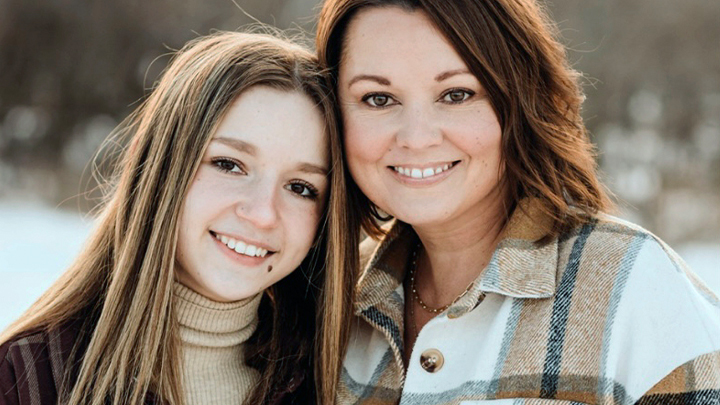Infection
Improvement project curtails risky line infections
Chelsea Malmberg and her daughter Emy, who required chemotherapy to treat a rare ovarian cancer. For Chelsea, looking after Emy’s central line at home provided a needed focus when life felt out of control. Photo by Candace Gillanders Photography.

The dressing for Emy’s central line. Photo supplied.

Some of the Alberta Children’s Hospital staff involved in the central-line improvement project are, from left: Clinical Nurse Educators Marsha Bucsis and Ashley McFetridge, and Registered Nurse Kelsey Frache, who are shown here with Chester, their training-simulation mannequin. Photo by Helen Catena.
Together, staff and families keeping patients safer
Story by Greg Harris | Photos by Candace Gillanders Photography & Helen Catena
CALGARY — Central line infections are becoming a rarity at Alberta Children’s Hospital (ACH) in Calgary, thanks to a quality improvement (QI) initiative involving both staff and family caregivers.
A central line, which is a catheter placed intravenously in a patient’s chest, allows doctors and nurses to deliver chemotherapy and other medicines to patients who need ongoing care. Central lines can become infected, however, which can lead to serious illness and even death.
Under the new quality initiative, clinicians have refocused on standardizing care and have developed additional resources and training for families. Together, they have helped cut infections.
For Chelsea Malmberg, whose daughter Emy, 15, required chemotherapy to treat a rare ovarian cancer, looking after her central line at home provided a needed focus when life felt out of control.
“It’s so hard when your child is sick — it feels like there’s not much you can do. Learning how to change Emy’s central line dressings at home was really important and gave me some purpose,” Chelsea recalls. It also spared the family numerous trips to hospital in Calgary from their home in High River.
“It was great that my mom was able to look after this,” Emy says. “Sometimes the line wouldn’t sit right, and it could be bothersome, but being able to adjust the placement at home was really nice.”
Dr. Shelina Jamal, an intensive care specialist at ACH who leads the QI initiative, says its success wouldn’t be possible without the combined efforts of healthcare providers and families alike.
“The entire team has worked together to achieve what was once thought to be an unattainable goal,” Dr. Jamal says. “This is a multi-disciplinary effort and one of the best examples I’m aware of where the data has served as a catalyst for change.”
According to Brett Simms, program manager in Data & Analytics, the hematology / oncology unit at ACH (where the improvement initiative is focused) recently celebrated eight months without a central line infection. Before this quality improvement work — locally branded as Safest Together — there were about two infections a month on the same unit.
“In addition to the obvious benefits for patients, there’s also a positive impact on the health system,” Simms says. He estimates the improvement project has resulted in savings of more than $2 million and prevented more than 400 days of hospitalization.
“A central line infection can increase length of stay by ten-fold and the overall cost of care by about the same,” Simms adds.
In order to achieve the improvements, clinical nurse educators and patient safety specialists developed resources to reduce variability in how central lines are cared for — both by healthcare providers and family.
“Nursing staff really took it to heart and the result has been a culture change where every aspect of central line care is questioned,” says Marsha Bucsis, an ACH clinical nurse educator who works with Safest Together.
A team of nurses, including Bucsis and Safest Together nursing leadership Coty Ong and Ashley McFetridge, developed central line care resources for families approaching discharge. These included handouts with step-by-step instructions about central line care at home, videos to supplement this information, as well as practice sessions with Chester, a simulation mannequin at ACH.
“At first it felt overwhelming,” Chelsea says. “There are quite a few steps involved in the process — it’s so critical to maintain a sterile field. However, the support provided was phenomenal. Nurses and doctors were fantastic in answering any questions we had.”
Initially it took Chelsea about an hour to change Emy’s bandages but that quickly shortened to 30 minutes. Emy did experience a skin rash at one point due to the regular use of alcohol swabs, but that was the only issue.
The hematology / oncology unit at ACH sees the most central lines, but this QI work will continue to spread to other areas of the hospital. Similar work is also underway at the Stollery Children’s Hospital in Edmonton.

